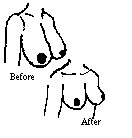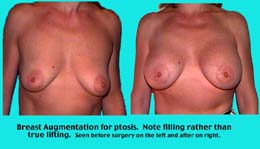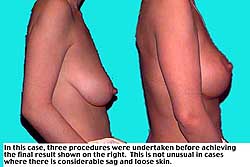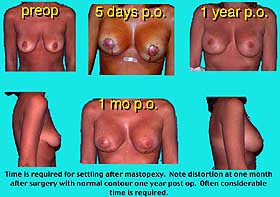
PREGNANCY, AGING, AND GRAVITY

Breast elevation, (mastopexy), is a surgical procedure designed to correct breast sagging. Breast sagging, or ptosis, the medical terminology, is a disturbing condition for women because it reflects the effects of pregnancy, aging and gravity on the breast position. The breasts appear droopy and less full than normal. The upper portion of the breasts appears flattened, and the lower portion descends below the crease beneath the breasts. Breast skin will often have reduced elasticity and become stretched or weakened. Symmetrical and naturally proportioned breasts with improved position are the goals of breast elevation, or mastopexy, as the operation is technically named. A patient’s understanding and input will aid the surgeon in determining the proposed breast size, shape and position, but it is essential to realize that there are definite limitations to the improvement that can be accomplished.
INDICATIONS
Many patients seek mastopexy following weight loss, pregnancy, lactation or menopause. The presence of ptosis indicates the inelastic nature of the skin and a corresponding decrease in breast volume. In others, the normal aging process may result in a loss of breast tissue, which is of sufficient degree that correction is desired.
Because there are various degrees of ptosis, the surgical treatment involves a range of possible corrections based primarily on the nipple-areolar position, the amount of excess skin, and the breast volume. Correction may be as simple as breast augmentation. For minor degrees of ptosis, this adds fullness and will give cleavage. It is especially useful when the skin has adequate elasticity. The obvious advantage of this approach is that it avoids visible scarring. For more advanced ptosis, skin is removed from around the areola allowing an upward repositioning of the nipple complex. This is usually combined with excision of the excess skin of the lower portion of the breast. Although this leaves some scarring beneath the breast, the improvement in shape and firmness often represents a satisfactory trade off. In all cases, the proposed incisions will be reviewed prior to surgery. In most cases, there will be a scar around the areola as well as vertical scar beneath the areola which generally curves into the fold beneath the breast. Mastopexy is often combined with augmentation when additional fullness is required. Along with the elevation, a small implant is inserted to improve fullness. When considering this operation, be sure to also read about breast augmentation.


COMPLICATIONS
Breast elevation can be a very gratifying procedure for the proper patient and enjoyed by many women. Its limitations are primarily those of the scars that are inevitable in this type of surgery. Although every effort is made to produce fine scars, the incisions made beneath the breast can have a tendency to widen or thicken in certain patients. Sometimes, incisions are slow to heal following this operation, although surprisingly, slow healing wounds may still result in very satisfactory scars. If they are not, later revision can be done under local anesthesia. It is usually best to wait about a year before considering revision, since the scars will improve with time.
Other possible complications include asymmetry of the breasts, infection, loss of sensitivity of the skin or nipple or skin necrosis. When breast augmentation is combined, there are the additional risks of this procedure. Furthermore, mastopexy must not be considered a treatment for breasts that are also too large. In these cases, breast reduction is required – a topic that is discussed separately.

THE PROCEDURE
The procedure generally takes two to three hours. The breasts are taped for several days with elastic tape to provide support. The recovery period is quite brief and the patient may return to light work a few days after surgery, although the final healing takes a while longer, depending on the extent of surgery and individual healing factors.
The desired shape will not be apparent for several weeks after surgery, and changes occur for several months. Furthermore, it is important to recognize that the cause of saggy breasts is poor skin elasticity. Therefore, while not common, patients who have this operation may return years later for a second procedure.
The major disadvantage of this operation is that it does not correct the basic underlying problem of the relative lack of skin elasticity that leads to the sagging in the first place.
Patients considering this operation should understand that while significant improvement is possible, the operation may fail to give as much improvement as some are hoping for. As in all surgery, realistic expectations are important. While there is still a place for mastopexy, in our practice this has largely been replaced by a combination of breast reduction with augmentation.

